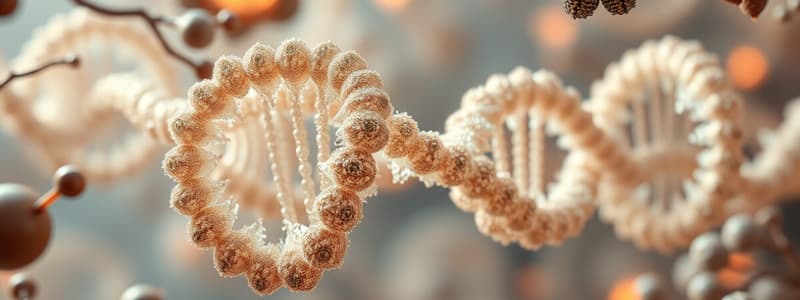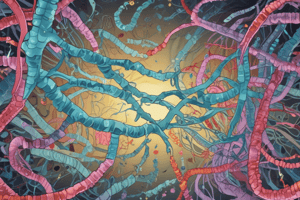Podcast
Questions and Answers
Which of the following methods can be used for stable transfection?
Which of the following methods can be used for stable transfection?
Stable transfection can lead to long-term expression of a transgene.
Stable transfection can lead to long-term expression of a transgene.
True
What is the role of integrase in viral transduction?
What is the role of integrase in viral transduction?
Integrase facilitates the integration of foreign genetic materials into the host genome.
Stable transfection is useful in long-term genetic and _______ studies.
Stable transfection is useful in long-term genetic and _______ studies.
Signup and view all the answers
Match the following methods of transfection with their characteristics:
Match the following methods of transfection with their characteristics:
Signup and view all the answers
Which statement correctly explains the distinction between transformation and transfection?
Which statement correctly explains the distinction between transformation and transfection?
Signup and view all the answers
Cloning vectors and expression vectors serve the same purpose in genetic engineering.
Cloning vectors and expression vectors serve the same purpose in genetic engineering.
Signup and view all the answers
What is a model organism?
What is a model organism?
Signup and view all the answers
The method that uses a gene gun to deliver DNA into plant cells is known as __________.
The method that uses a gene gun to deliver DNA into plant cells is known as __________.
Signup and view all the answers
Match the gene transfer methods with their characteristics:
Match the gene transfer methods with their characteristics:
Signup and view all the answers
Which of the following describes a characteristic of liposomal-based transfection reagents?
Which of the following describes a characteristic of liposomal-based transfection reagents?
Signup and view all the answers
Calcium phosphate is an example of a non-liposomal transfection reagent.
Calcium phosphate is an example of a non-liposomal transfection reagent.
Signup and view all the answers
What chemical interaction allows DNA to interact with the negatively charged cell membrane during the calcium phosphate technique?
What chemical interaction allows DNA to interact with the negatively charged cell membrane during the calcium phosphate technique?
Signup and view all the answers
Liposomal reagents facilitate DNA entry into the host cell through the process of __________.
Liposomal reagents facilitate DNA entry into the host cell through the process of __________.
Signup and view all the answers
Match the following transfection reagents to their categories:
Match the following transfection reagents to their categories:
Signup and view all the answers
What are liposomes primarily developed for?
What are liposomes primarily developed for?
Signup and view all the answers
Polyethylenimine (PEI) is known to interact electrostatically with proteins.
Polyethylenimine (PEI) is known to interact electrostatically with proteins.
Signup and view all the answers
Name one physical method used for DNA introduction into cells.
Name one physical method used for DNA introduction into cells.
Signup and view all the answers
The process of using lasers to create a temporary photopore in the cell membrane for DNA entry is known as ______.
The process of using lasers to create a temporary photopore in the cell membrane for DNA entry is known as ______.
Signup and view all the answers
Match the following methods with their descriptions:
Match the following methods with their descriptions:
Signup and view all the answers
Which of the following is NOT a physical method for DNA delivery?
Which of the following is NOT a physical method for DNA delivery?
Signup and view all the answers
What is a potential drawback of using high voltage in electroporation?
What is a potential drawback of using high voltage in electroporation?
Signup and view all the answers
Cationic lipids can form micellar structures to assist in gene delivery.
Cationic lipids can form micellar structures to assist in gene delivery.
Signup and view all the answers
What is one advantage of RNA transfection compared to plasmid or viral approaches?
What is one advantage of RNA transfection compared to plasmid or viral approaches?
Signup and view all the answers
Microinjection is a reliable method that does not cause cell death.
Microinjection is a reliable method that does not cause cell death.
Signup and view all the answers
What is a primary disadvantage of using chemical transfection?
What is a primary disadvantage of using chemical transfection?
Signup and view all the answers
The ____ method allows observation of the transfecting cell and can target any location on the cell.
The ____ method allows observation of the transfecting cell and can target any location on the cell.
Signup and view all the answers
Match the following transfection methods with their characteristics:
Match the following transfection methods with their characteristics:
Signup and view all the answers
Which of the following is a con of using Biolistic methods?
Which of the following is a con of using Biolistic methods?
Signup and view all the answers
RNA is generally more stable than DNA for transfection purposes.
RNA is generally more stable than DNA for transfection purposes.
Signup and view all the answers
What important features can affect the efficiency of mRNA transfection?
What important features can affect the efficiency of mRNA transfection?
Signup and view all the answers
Study Notes
Gene Transfer Methods
- Transformation involves uptake of naked DNA by bacteria, while transfection is a broader term for introducing nucleic acids into non-bacterial cells.
- Stable transfection leads to long-term expression by integrating foreign DNA into the host's nuclear genome.
Gene Transfer Techniques
- Methods include biological (horizontal gene transfer, transduction, and conjugation), chemical (using liposomes and calcium phosphate), and physical methods (e.g., electroporation).
- Biological methods use viral vectors like retroviruses for stable transfections; adenoviruses and herpes viruses may not guarantee stability.
Chemical Transfection Methods
- Liposomal transfection utilizes cationic lipids to form complexes with DNA that facilitate entry into host cells.
- Non-liposomal chemicals (calcium phosphate, dendrimers) create complexes that interact with the negatively charged cell membrane, promoting uptake by endocytosis.
Calcium Phosphate Technique
- Involves forming a precipitate with positively charged calcium ions and DNA before uptake by host cells, yielding low transfection efficiency (~1-2%).
Liposome Functionality
- Cationic lipids can create lipoplexes that enhance DNA delivery, with polymers like PEI facilitating effective gene transfer in vitro and in vivo.
Physical Methods of Gene Delivery
- Electroporation temporarily disrupts the cell membrane using electric pulses (1-1.5 kV) to allow DNA passage, suitable for hard-to-transfect cells.
- Other methods include sonoporation, micro-injection, scrape loading, particle bombardment, and laser creation of pores in cell membranes.
Pros and Cons of Physical Methods
- Electroporation is quick and effective for many cells, while biolistics allows for straightforward targeting.
- Limitations include potential cell damage from high voltage or physical methods, as well as the need for skilled microinjection.
RNA Transfer Advantages
- RNA transfer is increasingly adopted for RNA interference (RNAi) despite previous instability concerns.
- mRNA features (5' cap, IRES, poly-A tail) can enhance transfection efficiency and lead to rapid protein production without needing strong promoters.
General Notes on Gene Libraries
- Preparation of gene libraries involves strategizing methods for gene isolation and analysis.
- The advantages of RNA transfer include high expression rates and the ability to introduce multiple mRNAs to mitigate overexpression issues.
Studying That Suits You
Use AI to generate personalized quizzes and flashcards to suit your learning preferences.
Description
This quiz explores various gene transfer methods, focusing on transformation, transfection, and the different techniques used in the process. It covers biological, chemical, and physical methods, including specific techniques such as liposomal transfection and the calcium phosphate method. Test your knowledge on these important biotechnological concepts!




